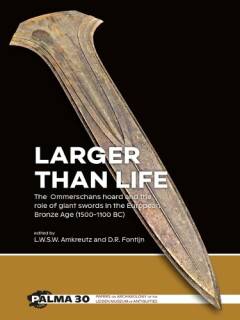
- Afhalen na 1 uur in een winkel met voorraad
- Gratis thuislevering in België vanaf € 30
- Ruim aanbod met 7 miljoen producten
- Afhalen na 1 uur in een winkel met voorraad
- Gratis thuislevering in België vanaf € 30
- Ruim aanbod met 7 miljoen producten
Zoeken
Larger Than Life
The Ommerschans Hoard and the Role of Giant Swords in the European Bronze Age (1500-1100 Bc)
Amkreutz Luc
€ 65,00
+ 130 punten
Uitvoering
Omschrijving
In 1896 a remarkable hoard was discovered near Ommerschans in the eastern Netherlands that included a spectacular object: a giant bronze sword. It was obtained by the landowner and kept by a forester, until it was first documented by archaeologist J.H. Holwerda in 1927. For over 85 years it remained in private ownership and inaccessible to science. Over time this sword, or rather dirk, would prove not to be a singular exception. Instead it is now part of a select family of six discovered in England (Oxborough and Rudham), France (Plougrescant and Beaune) and the Netherlands (Jutphaas and Ommerschans). In 2017 the Ommerschans hoard was obtained by the Dutch National Museum of Antiquities, bringing all six into the public domain.
The Plougrescant-Ommerschans type swords are some of the most spectacular finds of the European Bronze Age. They are extremely rare, beautiful, expertly crafted and too large and heavy to wield as weapons. Furthermore, their strong resemblance seems to have been crucial, as all six are extremely alike in design, decoration, metal composition and size (with the exception of Jutphaas). But why?
This book aims to unravel some of the mysteries surrounding this exceptional group of larger-than-life Bronze Age blades. It offers a detailed overview of the discovery and find context of the Ommerschans hoard, as well as a physical description and analysis of all finds. Also included is a comparative overview of the other five swords, including the primary publication of the Rudham dirk. The findings are subsequently interpreted focusing on their contextualisation within Bronze Age deposition practices, the importance of the visual cohesion of this group, the power and role of aggrandized objects and their potential purpose within the social and metaphysical realm of Bronze Age communities.
The Plougrescant-Ommerschans type swords are some of the most spectacular finds of the European Bronze Age. They are extremely rare, beautiful, expertly crafted and too large and heavy to wield as weapons. Furthermore, their strong resemblance seems to have been crucial, as all six are extremely alike in design, decoration, metal composition and size (with the exception of Jutphaas). But why?
This book aims to unravel some of the mysteries surrounding this exceptional group of larger-than-life Bronze Age blades. It offers a detailed overview of the discovery and find context of the Ommerschans hoard, as well as a physical description and analysis of all finds. Also included is a comparative overview of the other five swords, including the primary publication of the Rudham dirk. The findings are subsequently interpreted focusing on their contextualisation within Bronze Age deposition practices, the importance of the visual cohesion of this group, the power and role of aggrandized objects and their potential purpose within the social and metaphysical realm of Bronze Age communities.
Specificaties
Betrokkenen
- Auteur(s):
- Uitgeverij:
Inhoud
- Aantal bladzijden:
- 400
- Taal:
- Engels
- Reeks:
Eigenschappen
- Productcode (EAN):
- 9789464262605
- Verschijningsdatum:
- 13/08/2024
- Uitvoering:
- Paperback
- Formaat:
- Trade paperback (VS)
- Afmetingen:
- 208 mm x 277 mm
- Gewicht:
- 1179 g

Alleen bij Standaard Boekhandel
+ 130 punten op je klantenkaart van Standaard Boekhandel
Beoordelingen
We publiceren alleen reviews die voldoen aan de voorwaarden voor reviews. Bekijk onze voorwaarden voor reviews.











